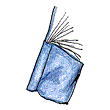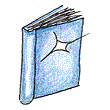As noted in Lesson 2, no special marking is needed to express third person subjects ("he", "she", "it", and "they") in Hul'q'umi'num'.
There are two different ways of expressing third person possession, depending on whether the possessor is a common noun or a proper noun (name).
Common Nouns
If the possessor is a common noun, then the suffix -s is added to the possessed word. The possessor follows the possessed word.
 |
kwthu xul'tuns tthu swuy'qe' | the man's pencil |
 |
Ni' 'untsu kwthu xul'tuns tthu swuy'qe'? | Where is the man's pencil? |
 |
Ni' 'untsu tthu poukws kwthunu sta'lus? | Where is my husband's book? |
The suffix -s is also used if the possessor is "he", "she", "it", or "they".
 |
kwthu swetus | his/her sweater |
 |
Sts'uts'e' 'u tthu lutem tthu swetus. | His/her sweater is on the table |
 |
Si'q 'u tthu shts'e'nutstun tthu poukws. | His/her book is under the chair. |
Proper Nouns
If the possessor is a proper noun, then no suffix is used on the possessed word. Instead, the possessed noun is followed by 'utl' and the possessor.
 |
tthu poukw 'utl' Mary | Mary's book |
 |
'E'ut tthu poukw 'utl' Mary. | Here is Mary's book. |
 |
'E'ut tthu lelum' 'utl' John. | Here is John's house. |